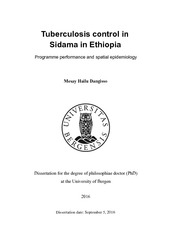| dc.description.abstract | The Sustainable Development Goals are to end the TB epidemic by reducing the incidence of TB by 90 % and by reducing mortality by 95% by 2035 from what was in 2015. Globally, access to TB diagnostic and treatment facilities (DOTS) has improved, and millions of TB cases have been notified and treated, which has resulted in many lives being saved. In recent years in Ethiopia, TB control services have been substantially expanded and decentralized, which has improved access to TB care. Assessing trends in TB programme performance (case notification and treatment outcomes), as well as the spatial distribution and variations of the disease, could help in understanding the differentials in accessibility to TB control services, the distribution of disease burden and help in understanding the effectiveness of TB control programmes. We assessed the distribution of- and accessibility to TB control facilities and trends in TB control programme performance in both urban and rural settings, by age category and by gender, and assessed the case notification rates of childhood TB over 10 years. We also assessed trends of the treatment outcomes of TB cases in order to identify high-risk groups for adverse treatment outcomes. Lastly, we explored spatial distribution and spatio-temporal clustering of the disease over 10 years to identify areas with the highest TB case notifications, and to identify the spatial variations in disease occurrence. Over 10 years, the accessibility to- and coverage of TB control facilities has improved. Thus, TB control service coverage increased by 36%, and the proportion of locations within 10 km of the nearest TB diagnostic facility also increased. However, we noted variations in physical accessibility between areas in the study area. The mean distance from the nearest smear microscopy unit was 7.6 km in 2003 and declined to 3.2 km in 2012. The substantial expansion of primary health-care services, including TB control facilities and community-based intervention, has contributed to an increase in TB CNRs and treatment outcomes. From this finding, we suggest that a concerted effort be made to improve the accessibility to TB control facilities in areas with low case notification and poor accessibility. An analysis of the trends of TB case notification and treatment outcomes in different settings based on the correct address, by age category and gender, and place of residence, could help understand the performance of TB control programmes and the epidemiology of TB within a community. We found that the CNRs for all forms of- and smear-positive TB increased steadily between 2003 and 2012. The CNR of smear-positive TB in the 45-year and above age groups rose by nearly fourfold. The disparity between men and women in CNR declined from 16 per 100,000 people in 2003 to eight per 100,000 people in 2012, with the male to female ratio also declining from 1.3:1 to 1.1:1. The increase in CNRs could be attributed to improved access to TB care and community-based interventions. Over a decade, treatment success increased, whereas mortality and lost-to-follow-up declined. However, more deaths occurred among smear-negative TB cases, in children and among older patients. Targeted interventions are needed to address high-risk groups for adverse treatment outcomes. The burden of childhood TB is one of the indicators used for assessing the ongoing transmission of the disease within a community. Assessing the case notification and treatment outcome of childhood TB could provide essential evidence to help understand the effectiveness of TB control programmes and the disease burden. Thus, we assessed childhood TB case notification and treatment outcomes over a decade. The mean CNRs for new cases of TB of all forms were 30 per 100,000 children, and no decline was observed in childhood TB cases over a 10-year study period. A community-based active case-finding intervention increased TB case notification in adults and in older children (10-14-year-olds); however, the case notification did not increase among younger children (less than five-years old). This could be explained by inadequate diagnostic facilities for childhood TB despite the community-based intervention, which focuses on symptomatic screening, followed by sputum-smear microscopy and the substantial expansion of TB control services. Better diagnostic facilities and interventions are required to increase case detection, and to improve treatment outcome among younger children. The burden of TB varies between- and within countries because of differentials in health service performance and the varying distribution of risk factors that increase the transmission of- and susceptibility to the disease. An analysis of the disease burden in coarser geographic or administrative units could hide the burden of the disease at lower administrative units. Therefore, we assessed the distribution of the disease in different geographic settings in the study area, and looked for the pattern of the disease transmission over years, as well as for evidence of spatiotemporal clustering. We found spatial variations in both the disease distribution and spatial and space-time clustering of the disease in the central, northern and northwestern areas of the study area. This could be explained by sustained transmission, disproportionate distribution of risk factors, varying access to TB care and varying TB programme performance, all of which require targeted interventions. In conclusion, in a population with a high prevalence of tuberculosis, we show that access to tuberculosis diagnostic and treatment facilities, in addition to the performance of TB control programmes, improved from 2003 to 2012. However, we identified areas with poor accessibility to diagnostic and treatment facilities. The low and constant case notification rate in childhood TB is an area of concern, and may indicate an underdiagnosis of childhood tuberculosis. Moreover, the distribution of tuberculosis has changed over time, and in different areas, thereby suggesting a high transmission or variable access to diagnosis and treatment. As a result, the variations in case notification rates, and in accessibility to tuberculosis control services represent challenges on how to improve the organization and performance of TB control. | en_US |
